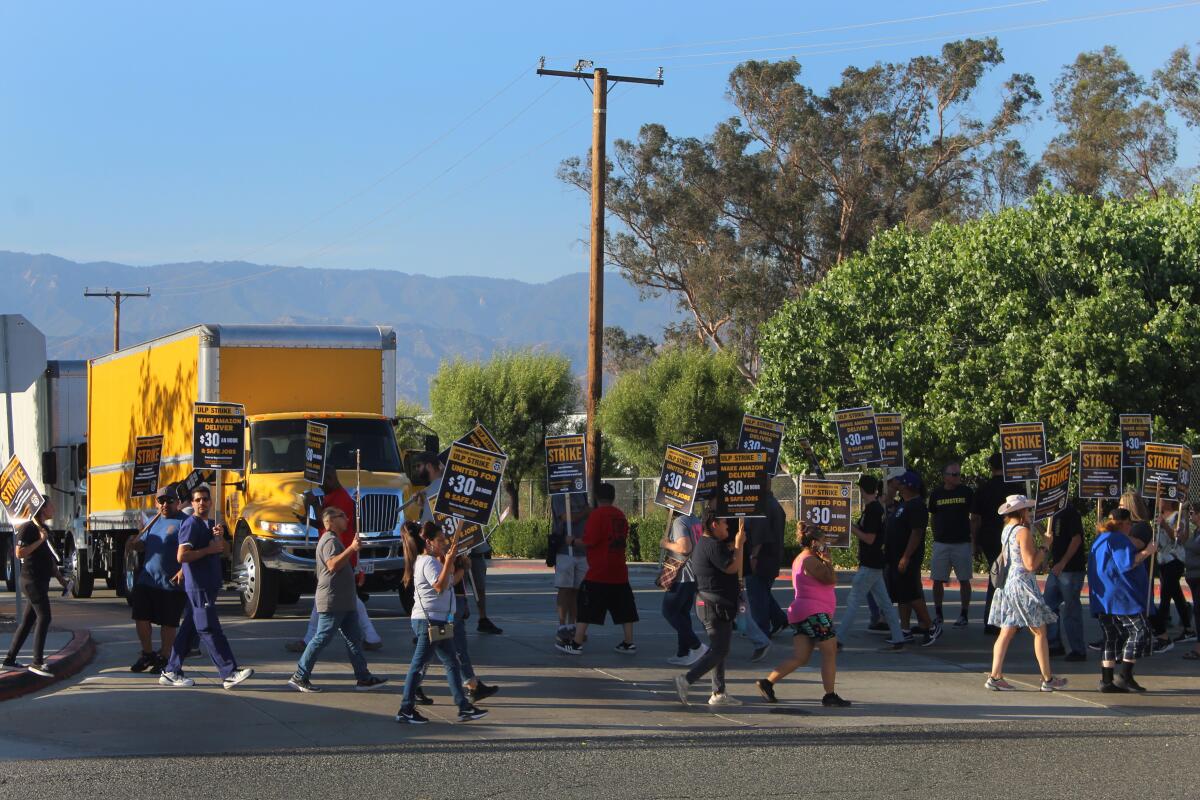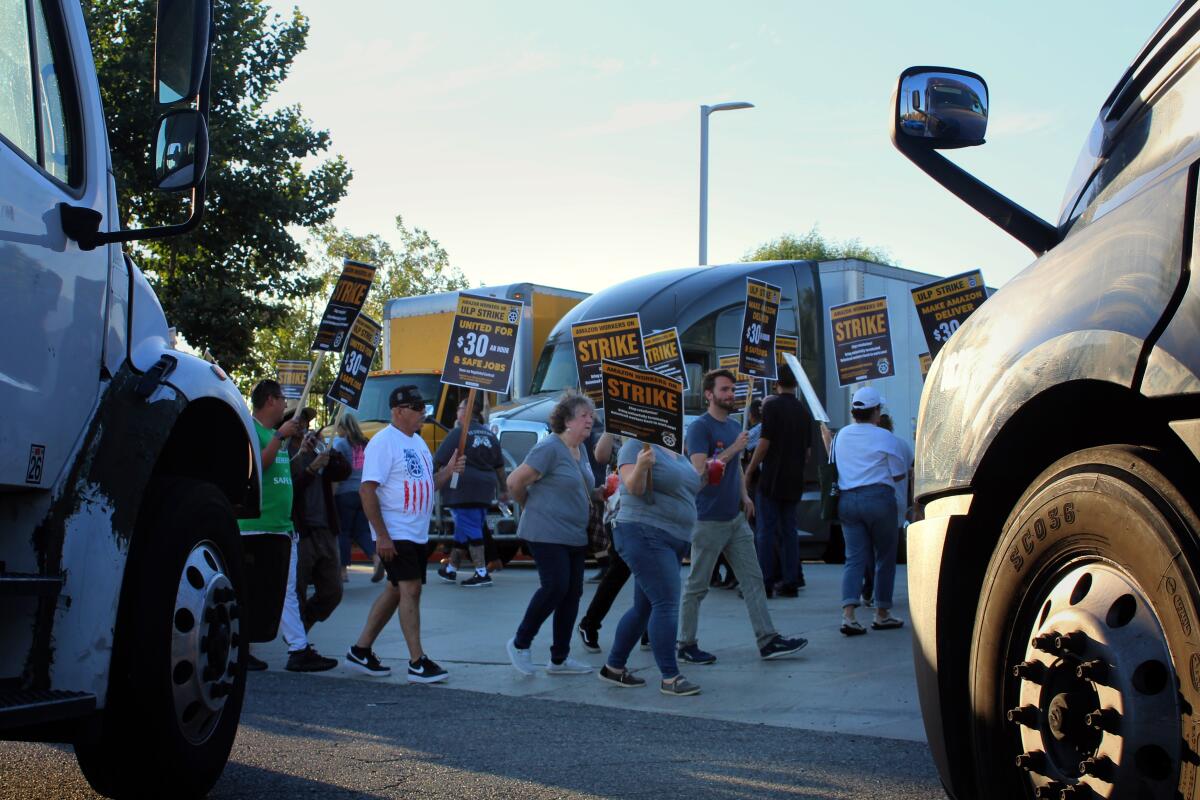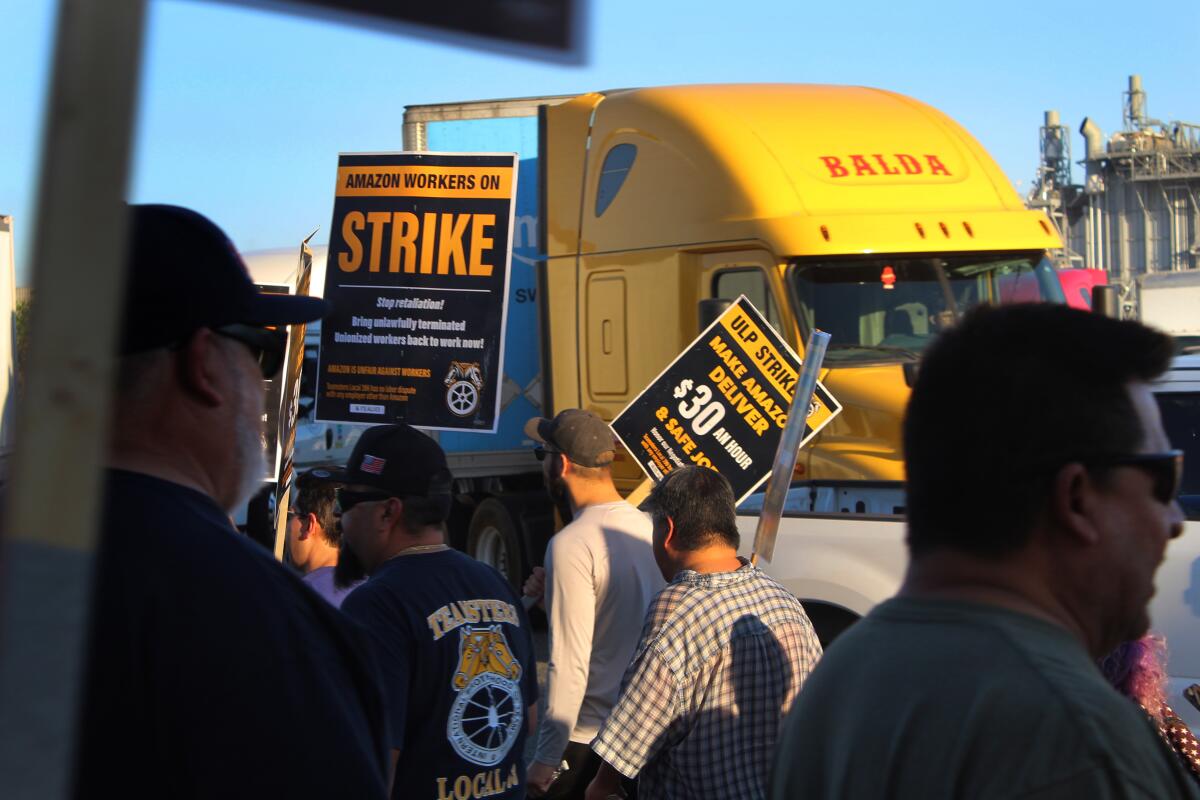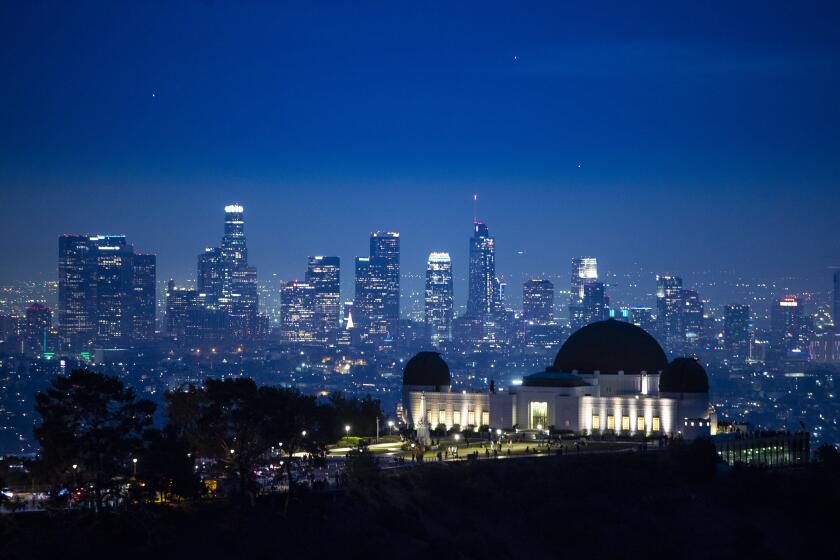Three months ago they unionized. Now a strike by Amazon contract drivers is heating up

- Share via
Two days after Amazon Prime Day, a group of over 60 Palmdale Amazon contract drivers, backed by Teamsters and community members, picketed outside Amazon’s ONT 5 warehouse, blocking trucks from entering or leaving the San Bernardino facility.
They waved signs demanding that Amazon recognize their contract, which stipulates a $30-per-hour wage by September, and safe working conditions, as they marched across the street in 95-degree heat.
The July 13 picket was one of 10 that these drivers have organized at Amazon warehouses in Michigan, Georgia and other states since they went on strike last month. Though they made deliveries for Amazon, they worked for Palmdale-based Battle-Tested Strategies, which since 2019 has been one of many small companies that Amazon contracts with to run the retailing giant’s short-distance deliveries under its Delivery Service Partner program.
Amazon canceled its contract with BTS in June, citing “poor performance.” Since then, the Palmdale contract drivers, who unionized with the Teamsters last April, have engaged in an unfair labor practice strike, demanding that Amazon recognize and bargain with their unit.
Cecilia Porter is one of the contract drivers who formerly made deliveries for Amazon through BTS from DAX8, Amazon’s Palmdale facility. She said BTS employees unionized in hopes of getting higher wages and better working conditions, but the company refused to meet with the drivers’ union.
“Some vans really don’t have AC and we tell them and they don’t do anything about it. Sliding doors don’t open, which are used to get the packages in and out,” said Porter, who led Thursday’s picket and also has traveled to pickets in New Jersey, Connecticut and Massachusetts. “ It’s too hot out there. And we work hard for $19.75. Who’s that going to help? I live paycheck to paycheck.”
The level of responsibility that Amazon has for the drivers and their well-being is disputed by the shipping giant. Amazon says that the subcontracted drivers are not Amazon employees, and has not agreed to bargain with their union. In a statement to The Times, Amazon spokesperson Eileen Hards said that at Amazon, vehicles without properly functioning air conditioning are immediately removed from service and that its delivery partners decide on break times and pay rates.
“The Teamsters are being intentionally misleading and continue to promote a false narrative. Their contract is with Battle Tested Strategies, not Amazon,” Hards stated. “The facts remain that months ago, Amazon terminated its contract with Battle Tested Strategies effective June 24. That company and their employees no longer deliver Amazon packages.”
For the record:
1:56 p.m. July 28, 2023A previous version of this article misidentified Teamsters Local 396 as Local 365.
The dispute leading up to the strike began in late April, when 84 Palmdale contract drivers for Amazon joined Teamsters Local 396, settling a tentative contract with BTS, which agreed to voluntarily recognize the union. At the time, BTS owner Johnathon Ervin told Bloomberg News that he hoped to include Amazon in the bargaining process to further enhance the morale and welfare of the drivers.
However, on April 14, weeks before the union’s public announcement, Amazon told Ervin that it would terminate its contract with BTS on June 24, months before it was originally set to expire in October. Hards said that Amazon canceled the contract due to six breaches of contract including failing to pay its insurance providers. In mid-June, Ervin told Wired that he was contesting the breaches and that he resolved three of the breaches last year, although they remained on BTS’ record. He claimed that Amazon ended the contract because he had voiced concerns about his employees’ working conditions.
The Teamsters allege that Amazon terminated BTS’ contract in retaliation for the drivers unionizing and have filed a complaint against Amazon with the National Labor Relations Board.
The director of the Teamsters’ Amazon division, Randy Korgan, said that the level of control Amazon had over the drivers’ working conditions, which included dictating routes and performance expectations, meant the retail giant was acting as a joint employer with BTS and therefore was ignoring its responsibility to bargain with the drivers.
“In my 30 years I’ve never seen a more restrictive relationship between a company and its subcontracting agency,” Korgan said. “We’re trying to show Amazon that they need to rewrite their operations because what they’re doing is illegal. Their business model has been misleading. We didn’t rewrite the facts. We’re taking what Amazon did and holding them accountable.”
United Parcel Service drivers, who are also represented by the Teamsters and do some deliveries for Amazon, reached a tentative contract with UPS this Wednesday, averting a potential national strike. The union said the new UPS contract will set “a new standard in the labor movement.”

As the popularity of online shopping has grown, so has the logistics industry’s presence in Southern California. Over 1,100 warehouses have been constructed in the area since 2010, the Guardian reported in December. Amazon, which has invested hundreds of millions of dollars in the region, opened a regional air hub in San Bernardino in 2021, the seventh Amazon air site in California, and has plans to finish construction of its largest fulfillment center in Ontario in 2024. It also operates a number of logistics centers across the region.
Recent years have also seen more union drives at Amazon warehouses in California and other states, with mixed results. Last April, workers at an Amazon warehouse in Staten Island, N.Y., voted to unionize with the grassroots Amazon Labor Union, becoming Amazon workers’ first U.S. union. The company continues to challenge the results. This month, the NLRB ordered Amazon to bargain in good faith with those employees, finding merit to a series of complaints that alleged Amazon had violated labor laws by refusing to come to the bargaining table.
In Riverside County, a group of Amazon warehouse workers in Moreno Valley filed a petition to hold a union election last October but withdrew it weeks later after Amazon challenged whether the organizers had gathered enough signatures. Amazon workers in Bessemer, Ala., held a second union vote in 2022, after losing the first in 2021, but with a narrow vote difference, objections and contested ballots on both sides, the results are still too close to call. Last month, the NLRB ordered a hearing for September to go over these contested votes and allegations of unfair labor practices.
The Palmdale contract drivers are not the first employees of an Amazon delivery partner to unionize. In 2017, drivers working for Silverstar Delivery in Brownstown, Mich., voted to join the Teamsters. But weeks later, some drivers reported they were fired for joining the union, and a shop steward told BuzzFeed News that Silverstar had shut down its Michigan location months after. Although the Teamsters named Amazon in a labor complaint related to the matter, according to Buzzfeed News, Amazon told the NLRB it was a contractor, and not the drivers’ employer.
The model with which large employers like Amazon subcontract work to other companies is becoming increasingly common, said Ellen Reese, chair of the labor studies program at UC Riverside, who studies warehouse and labor economics in the Inland Empire. Under this structure, Reese said, it becomes more difficult for workers to exercise their rights and bargain collectively with their employers.
“I think the case involving the drivers in Palmdale is really important,” Reese said. “This campaign, if it’s successful, will set a precedent that employers can’t just contract away the rights of their workers and that they still have responsibilities to provide good terms of employment to people that help their businesses to run.”
Drivers first staged a walkout from the DAX8 Palmdale facility on June 15, demanding that Amazon recognize and bargain with the Teamsters union over pay and working conditions. They walked out again on June 24, the day their contract would be terminated, starting the ongoing strike.
“After unionizing, we feel like we’ve got more power on our hands to be able to not just defend ourselves, but to defend even the little people out there that don’t have a voice or are too scared to stand up for what’s right,” said Heath Lopez, who worked as a delivery driver at Amazon’s Palmdale facility the past three years.
In the weeks since, the strike extended to other parts of California and other states. Drivers have also continued to picket at the DAX8 Palmdale facility six or seven days a week, said the Teamsters.
Workers striking at Amazon’s DDT6 hub in Pontiac, Mich., invited delivery drivers to join their picket line so they would stand in solidarity with one another, said Alicia Ozier, an employee and union organizer at the facility. Much like the Palmdale drivers, Ozier said, Pontiac workers struck July 14 for increased safety protections, stricter regulations for dealing with extreme heat and higher pay. She said that prior to the strike, she experienced retaliation for her organizing efforts.
“We’re all employees of Amazon. We’re all getting the same unfair, unjust treatment,” she said.
Amazon did not respond to questions about the strike at its Pontiac facility. Hards said the company doesn’t retaliate for union organizing.
Several community groups and local unions are supporting the Palmdale drivers. During the San Bernardino picket on July 13, Tania González, an Inland Empire activist with the People’s Collective for Environmental Justice, noted the intersections between environmental and labor justice in her community, where warehouse-related pollution has become a growing concern for residents.
“These workers did begin their fight because of the heat issues with the facilities,” González said. “Climate change is getting worse. Their conditions within their trucks and the facilities are not getting any better with climate change. So it’s important for us to support them.”

Strengthening heat protection measures has been at the center of some Amazon workers’ unionizing efforts. Workers in Pontiac who walked out earlier this month said Amazon’s industrial fans and temperature control systems weren’t sufficient to combat hot conditions.
Similarly, last summer, workers in San Bernardino’s Amazon Air hub walked off the job, demanding higher pay and relief from what they said were unsafe work conditions caused by extreme heat. A few of the Amazon Air workers joined drivers’ pickets in San Bernardino and Palmdale this July. So far this month, the average daily temperature in Palmdale has ranged from 69 to 110 degrees, and from 61 to 102 degrees in San Bernardino.
During previous summers when he worked as a Palmdale Amazon contract driver, Michael Lieb said conditions in his van were often worse during the week around Amazon’s Prime Day, as he was often expected to deliver more packages in the same amount of time.
“Prime week should never be in the peak season of the heat,” Lieb said.
Hards said Amazon has a robust heat mitigation plan and that the company’s heat-related safety protocols often exceed industry standards and federal guidance. She said professionals monitor these systems and can take extra steps if needed.
“The health and safety of our employees is always our top priority,” she said.
Amazon, Hards said, is committed to the “safety of drivers and the communities where they deliver,” was investing in supplies to help the drivers stay cool and hydrated and strongly encouraged drivers affected by the heat to return to the station.
Korgan said he expected the Palmdale drivers’ pickets to keep growing to include more warehouse workers and community members.
“Amazon wants to create a narrative that this is a futile process, that these are outsiders,” Korgan said. “These are working people fighting to have middle class jobs.”
More to Read
Sign up for Essential California
The most important California stories and recommendations in your inbox every morning.
You may occasionally receive promotional content from the Los Angeles Times.











